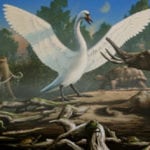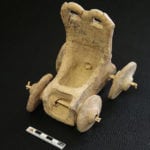 Weird Stuff
Weird Stuff  Weird Stuff
Weird Stuff  Animals
Animals 10 Inspiring Tales of Horses Being Human
 Mysteries
Mysteries Top 10 Haunting Facts About the Ghost Ship MV Alta
 History
History 10 Surprising Stories About the Texas Rangers
 Humans
Humans 10 Philosophers Who Were Driven Mad by Their Own Theories
 Miscellaneous
Miscellaneous 10 Video-Game-Worthy Weapons and Armors from History
 Weird Stuff
Weird Stuff 10 Psychics Who Accurately Predicted Wartime Events
 The Arts
The Arts 10 Pieces of Art Inspired by a Broken Heart
 Health
Health 10 Science Fiction-Sounding New Medical Treatments
 History
History 10 Surprising Facts About the Father of Submarine Warfare
 Weird Stuff
Weird Stuff 10 Times Real Laws Were Based on Bizarre Hypotheticals
 Animals
Animals 10 Inspiring Tales of Horses Being Human
 Mysteries
Mysteries Top 10 Haunting Facts About the Ghost Ship MV Alta
Who's Behind Listverse?

Jamie Frater
Head Editor
Jamie founded Listverse due to an insatiable desire to share fascinating, obscure, and bizarre facts. He has been a guest speaker on numerous national radio and television stations and is a five time published author.
More About Us History
History 10 Surprising Stories About the Texas Rangers
 Humans
Humans 10 Philosophers Who Were Driven Mad by Their Own Theories
 Miscellaneous
Miscellaneous 10 Video-Game-Worthy Weapons and Armors from History
 Weird Stuff
Weird Stuff 10 Psychics Who Accurately Predicted Wartime Events
 The Arts
The Arts 10 Pieces of Art Inspired by a Broken Heart
 Health
Health 10 Science Fiction-Sounding New Medical Treatments
 History
History 10 Surprising Facts About the Father of Submarine Warfare
10 Terrifyingly Huge Extinct Versions Of Adorable Animals
We’ve covered the topic of gigantic animals before, looking at ancient and terrifying huge versions of snakes and scary carnivorous reptiles. Now we’re going to take a look at ordinary animals that don’t usually make people feel afraid. From adorable penguins to sleepy sloths, there used to be giant versions of all these animals. No matter how cute their relatives are today, the giant versions are the things of nightmares.
10 Penguins
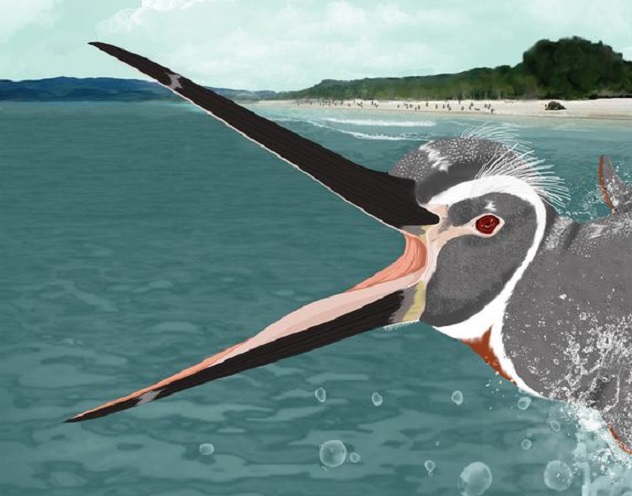
Penguins are one of the most popular animals in the world. From documentaries on the extreme weather some species endure to animated classics depicting their zany antics, there is no doubt they are a beloved bird. Today there are 17–19 penguin species, but not all scientists agree on the exact number. The smallest species is the little blue penguin, who are around 25–30 centimeters (10–12 in) tall and have an average weight of 4–7 kilograms (2–3 lbs). The largest is the famous emperor penguin, who live in Antarctica, reach heights of 113 centimeters (3.7 ft), and average in weight from 22–40 kilograms (50–90 lbs). Larger penguins tend to live in the colder climates, while more temperate locations—such as Australia and the Galapagos—are home to smaller species.
The emperors may be the biggest penguin today, but they can’t compare to their giant ancestors, who roamed the planet 36 million years ago. The water king could nearly stand face to face with modern humans at 152 centimeters (5 ft) tall and may have weighed up to 82 kilograms (180 lbs). These giant penguins were discovered in Peru in 2010.
Besides being one of the biggest species of penguin ever to be uncovered, they were also more colorful than their descendants. The water king didn’t don the usual black and white tuxedo, but opted for gray and red instead. Scientists hypothesize that this giant penguin wasn’t as graceful or fast in the water as modern penguins because it hadn’t evolved the specializations that give their animal family such speed in the ocean, which is why it may have still been rocking the differently colored plumage.
9 Wombats
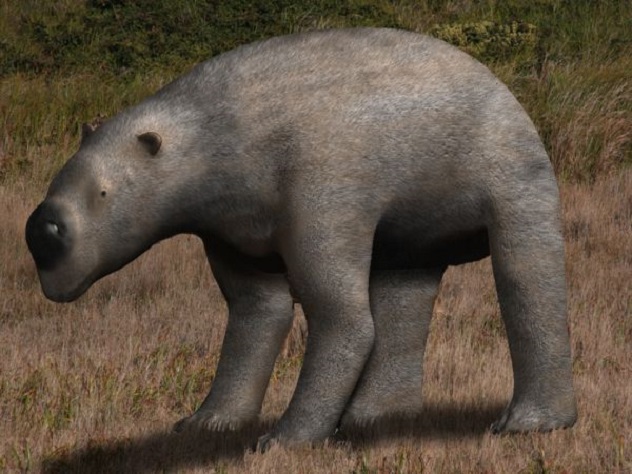
Australia is home to all kinds of unique and bizarre creatures. One of the cutest is the wombat. It’s a large and chubby marsupial that lives in Australia and nearby islands. They have a little pouch where their still developing babies mature after being born. Wombats are burrowing animals that grow up to 119 centimeters (47 in) long and weigh a maximum of 36 kg (80 lbs), but these nocturnal tunnel dwellers used to be much, much larger. Their ancestors, the diprotodon, were the largest marsupials to roam the planet.
Diprotodons would have dwarfed their modern descendants, growing up to 170 centimeters (5’7″) to their shoulders, 305 centimeters (10 ft) long, and weighing in at a whopping 2,500 kilograms (2.75 tons). To put that in perspective, that’s a little heftier than modern white rhinos. Their pouches were big enough to fit a grown man. You wouldn’t want to come across a mob of those guys. Roaming Australia’s forests and scrub land, they certainly did not burrow in the ground—they instead made their homes among the vegetation that made up most of their diet. These giants went extinct around 25,000 to 45,000 years ago, although they first came on the map 1.6 million years ago. They were preyed upon by another giant animal, a 6-meter (20-ft) prehistoric lizard, the megalania.
8 Platypus
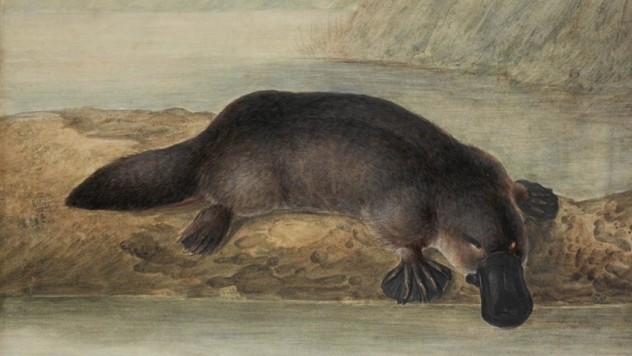
Another odd animal hailing from Australia’s previously isolated land is the platypus. By all appearances, it is one of the strangest animals alive today. When confronted with stories of the platypus before its official discovery, scientists thought it was a joke—an egg-laying, beaver-tailed, duck-billed, poisonous otter. Oh, it’s also a mammal. Only the males are venomous, having a spur on their back feet. Modern platypuses are carnivores. Including their tail, they can grow up to 51 centimeters (21 in) in length and weigh 1.4 kilograms (3 lbs).
Even these bizarre creatures had a megafauna ancestor. Obdurodon lived in northern Australia and there were several kinds. The Obdurodon tharalkooschild was over 91 centimeters (3 ft) long. The oldest evidence of platypuses dates back 26 million years, but they are thought to have thrived 5–15 million years ago. These beasts are known to have inhabited the Riversleigh area of Australia during the early Miocene epoch. The landscape is thought to have caves, waterways, rainforests, and spacious forests. The giant platypus had teeth and probably ate a wider variety of food than modern platypuses, perhaps including big fish and frogs. Other giant platypuses are thought to have lived in South America, going extinct around 61 million years ago. A limited fossil record has scientists still curious about these ancient beasts.
7 Andean Condor
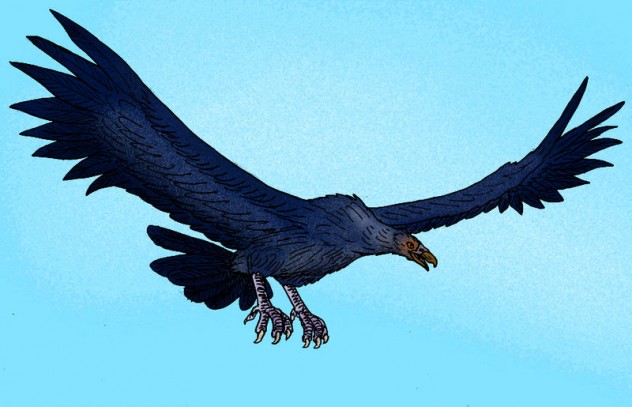
Andean condors are one of the largest flying birds in the world. They are named after their range, which stretches the mountainous Andes, the vast region of Patagonia, and the coast of South America. These massive birds have wingspans of 305 centimeters (10 ft) and have to carry a weight of 15 kilograms (33 lbs). Condors glide through the air searching for carcasses to scavenge for their vulture carnivore diet. Andean condors perch on rocky cliffs, as the wind that is whipped up in these areas helps to carry their weight. These hygienic and healthy birds have been recorded to live well into their 70s. While they have bald heads, their feathers change in hue in response to emotional stimuli. These modern giant birds are endangered, but there are a number of projects aiming to protect pockets of their habitats.
The biggest bird ever to soar through the sky was the Argentavis magnificens, whose closest living relative is the Andean condor. Argentinavis were truly gigantic, with a wingspan of 7 meters (23 ft) and weighed up to 70 kilograms (155 lbs). They were the size of some small airplanes and soared on hot air like their Andean condor cousins.
Scientists disagree whether or not these massive birds were hunters or scavengers. One argument is that they swallowed small animals like rabbits whole, a theory supported by the fossil record. Other experts suggest that their size and lack of maneuvering skills in the air indicates that they’d have little success when hunting, meaning they’d need to scavenge to support their dietary needs. These scary ancient version of the modern condor, who also lived in South America’s Patagonia region, went extinct some 6 million years ago.
6 Camels
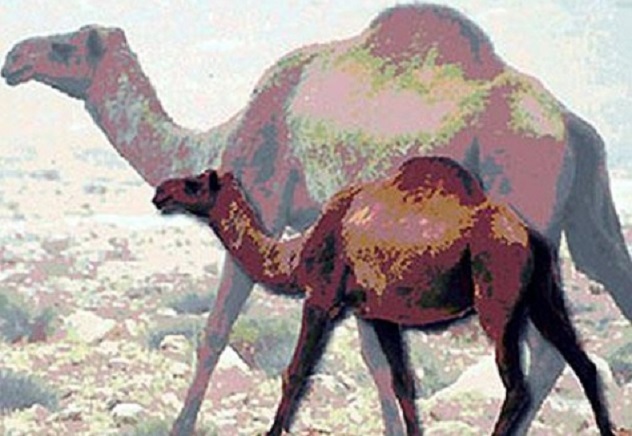
Camels are ubiquitous in deserts, where they’ve been used as transport animals for thousands of years. They have a remarkable ability to survive 4–5 days without food and water due to the huge deposits of fat in their humps. There are multiple species of camels, some with two humps and others with one. Camels live in hot climates, but they don’t sweat—they hold their water in their fat for when it’s needed most. The other major benefit of having so much fat in one place means that they are less insulated, allowing them to stay cool in hot weather. They consume huge amounts of water at a time, upwards of 189 liters (50 gal) when thirsty. Camels are not small creatures, and if you’ve ever seen one run, you know they are hilarious to watch when they gallop. The camels of today vary in weight between 400-1,000 kilograms (900–2,200 lbs) but all of them are between 167–198 centimeters (5’6″–6’6″) in height.
Modern camels are nothing compared to their biggest camel ancestors, though. The Syrian camel lived 100,000 years ago and was discovered deep in the Syrian desert by Swiss scientists. This giant camel would tower over its modern day relatives at a whopping 365 centimeters (12 ft) tall. The area they roamed used to be savanna and was also inhabited by ancient people who hunted these giant dromedary (one-humped) camels. It’s unknown whether they co-existed with Neanderthals or Homo sapiens, as only a few bones have been found so far. As more fossils become uncovered, the mystery of the giant Syrian camel—and the evolution of modern camels—will become clearer.
5 Kangaroos
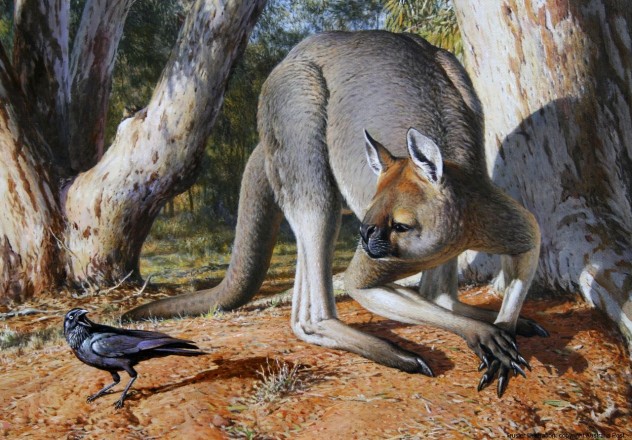
Kangaroos are well known for the way they bound across the landscape and the way joeys—or baby kangaroos—are carried around in their mother’s pouch. Kangaroos even show up on many dinner plates, but red kangaroos are not hunted as much as other kangaroo species due to their low numbers in Australia. The red kangaroo is a large animal in its own classification, the biggest of all the marsupials on earth. They reach heights of 160 centimeters (5’3″) and can weigh over 90 kilograms (200 lbs). They’d be tough competitors in a track and field race, as they can jump 183 centimeters (6 ft) high and can complete an 8-meter (25 ft) long jump. They can travel faster than 56 kilometers per hour (35 mph). This speed varies depending on gender, with females being faster than males.
Modern kangaroos, particularly the males, can put up a vicious fight if confronted. However, they’d be hard pressed to win a fight against their ancestor, the Procopodon goliah, which is the largest known kangaroo to ever exist. The Procopotdon goliah was a short-faced kangaroo, sporting claws on their hands and forward-facing eyes. These giants reached estimated heights of 198–299 centimeters (6’6″–9’10”) and weighed in at 200 kilograms (440 lbs). They most likely lived in harsh, semiarid climates and had adapted to a diet of tough fibrous plants. Like the kangaroos of today, their extremely small babies developed in their mother’s pouch.
Unlike some of the other animals on this list, whose closest living relatives are similar animals, the closest living relative of the Procopodon goliah may not be a kangaroo, but a wallaby that lives in Western Australia. Another point of contention on the history of giant kangaroos is why they went extinct 40,000 years ago. For years, scientists have speculated that they died off due to climate change, but recent evidence points the finger at humans who may have hunted them into the fossil record. Either way, these giant creatures would surely give us a fright if we saw them leaping towards us today.
4 Beavers

Beavers are members of the rodent family who feverishly work to manipulate their environment to fit their needs. Beavers make their homes in waterways, often building dome-shaped homes out of trees that they chop down using their strong, ever-growing teeth. These industrious builders sustain themselves on plants but can put a fierce fight if they feel the need. Beavers are all about family—they mate for life and the dam homes they build are for entire extended families. In the rodent family, they are second in size to only the capybara. Beavers vary in size from 78–122 centimeters (2’6″–4′). You don’t want to come across an angry beaver protecting his family.
You especially wouldn’t want to come across the giant beaver who lived in North America during the last ice age. These megafauna could have squished today’s biggest rodent, growing up to 244 centimeters (8 ft) in length and weighing an incredible 100 kilograms (220 lbs). While we can imagine today’s beavers as happy homemakers, no one knows how exactly the giant beavers lived. They had 15-centimeter (6-in) incisors and ground up plants with their blunt teeth. The two theories for their extinction are the same as many other megafauna on this list—either climate change or being hunted by humans. They went extinct around the same time humans came onto the scene 10,000 years ago.
3 Armadillos
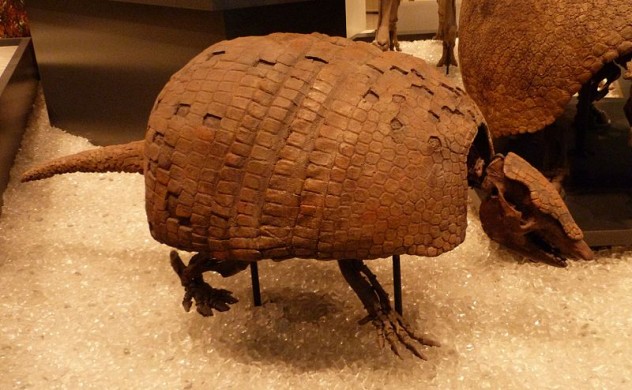
The poster child for growing your own armor is the armadillo. They are an ancient group who live in the Americas, mainly Latin America. While the trademark of an armadillo might its ability to curl up into a hard ball protected by its shell, only the North American variety pull off that maneuver. What makes all armadillos unique is that they are the only mammal who rock living, bony shells. When they’re not sleeping for 16 hours of the day, armadillos are burrowing in the ground and munching on bugs that they hunt down by scent. If they get tired of eating insects, there are a lot of other things on the menu, including plants, tiny animals, and scavenged meat. Armadillos vary wildly in size, ranging in weight from 85 grams (3 oz) to 54 kilograms (120 lbs) and growing in size from 13–38 centimeters (5–15 in), depending on the species.
That’s no small animal, but it’s nothing compared to the armadillo’s prehistoric grandparents, the holmesina. Holmesina were large armored mammals that they reached epic sizes of 198 centimeters (6’5″ ft) in length, 100 centimeters (3’4″) tall, and most likely weighed some 300 kilograms (660 lbs). They had hard shells and grew armored helmets on their heads. They were definitely larger and scarier than their modern offspring, but these gentle giants were herbivores. Either way, we wouldn’t want to come face to face with one of these megafauna.
2 Pigs
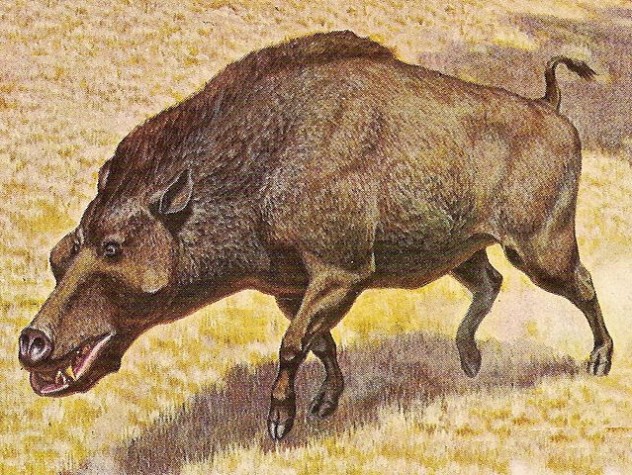
Pigs can either be adorable house pets or—when riled up—dangerous killing machines. Tiny potbellies became the trendiest pet in 2010, when everyone from Victoria Beckham to Paris Hilton was rumored to own a mini-pig. On the other hand, domesticated hogs can be dangerous. In 2012, an Oregon farmer was eaten by his pigs. Pigs are an animal that can easily revert back to their wild state after only a few months of being feral. Tusks will grow, the pigs will get hairy, and they will begin to act extremely aggressive. Pigs will eat anything, making them true survivors, and can weigh over 454 kilograms (1,000 lbs). The largest wild boar doesn’t grow quite as huge, at 272 kilograms (600 lbs) and 213 centimeters (7 ft) in length, but is more dangerous.
Coming face to face with an angry wild boar would be terrifying, but imagine what it’d be like to come up against one that is 365 centimeters (12 ft) long, almost 2 meters (6 ft) tall, and carrying an incredible 1,000 kilograms (2,200 lbs). Thankfully, we don’t have to worry about that today, but if you had a time machine and went back 5–23 million years ago, you could go head to head with the daeodon. The daeodon was one of the largest entelodont artiodactyls that has ever lived. Complete with tusks and giant crushing jaws, these omnivorous monsters were the size of rhinos and perhaps more vicious than their wild hog decedents. The name daeodon comes from its previous name of Dinohyus, which translates from Greek to “terrible pig.” Yikes.
1 Turtle
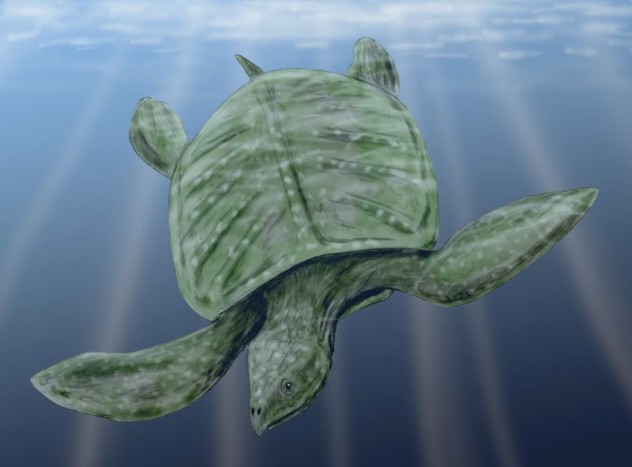
Turtles are lovable shelled critters. They’re the only reptile to have a shell but lack teeth. They also hold the distinction of being the only animal with both a backbone and a shell. Turtles are aquatic dwellers and usually have webbed feet. From the fresh water snapping turtle, whose jaws could break off your big toe in one go, to sea turtles who only come on land to lay their eggs, turtles are a diverse family of animals. Not all turtles can hide completely inside their shells, but none of them can crawl out of their shells. That’s because their shells are a part of their body, made out of the same material as fingernails, and attached to the spine and ribcage. Turtles and their closely related tortoise cousins live into old age, sometimes over 150 years. The largest turtle is a leatherback named Dermochelys coriacea, who has a shell that is 240 centimeters (8 ft) long.
Turtles have been around for 200 million years, but some early turtles weren’t anything like modern turtles in terms of size. The largest turtle we know about was the archelon, first discovered in South Dakota in the 1970s and one of the most complete skeletal fossils found to date. The archelon is 4.5 meters (15 ft) from head to tail and 5 meters (16’6″) wide from flipper to flipper. They were sea turtles who weighed over an incredible 2,000 kilograms (4,500 lbs). Scientists think archelons snapped up squids from the sea during their 100-year lifespans. If the modern snapping turtle can snap a twig in half and the heaviest one ever found was 30 kilograms (68 lbs), consider what a massive two-ton monster could do.
When Kristance isn’t compulsively traveling the globe, she’s looking up weird facts and making awkward YouTube videos. An avid culture geek, she’s a trained anthropologist and archaeologist. Connect with her on Twitter or read about her adventures at diggingtoroam.com.
